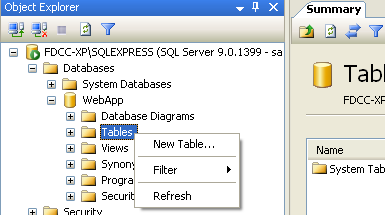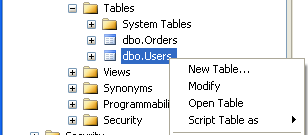Crear una Aplicación Web Vulnerable
Para crear nuestra aplicacion web vulnerable, tendra que descargar SQL Server Management Studio Express desde: http://www.microsoft.com/downloadS/details.aspx?familyid=C243A5AE-4BD1-4E3D-94B8-5A0F62BF7796&displaylang=en
Instale SQL Server Managment Studio Express, aceptando todo los valores por defecto de la instalacion luego ejecutelo en "Start" -> "All Programs" -> "Microsft SQL Server 2005" -> "SQL Server Management Studio Express".
Cuando se inicie Management Studio, seleccione "SQL Server Authentication" y conectese usando el usuario "sa" y contrasena "password1".
Haga click derecho en "Databases" en "Object Explorer" y seleccione "New Database".

Escriba "WebApp" como nombre de la base de datos y click en "OK". En "Object Explorer", expanda "Databases", luego expanda la base de datos "WebApp". Click derecho "Tables" y seleccione "New Table".

Cree una nueva tabla llamada "users" con el nombre de columna y tipos como se muestra abajo en la imagen.

Guarde la table "users", click derecho y seleccione "Open Table".

Introduzca algunos datos de ejemplo en la tabla y guardelo todo.

Bajo del árbol principal en "Object Explorer", expanda "Security", luego "Logins". Click derecho en "Logins" y seleccione "New Login".

En la ventana "Login - New", seleccione "Search", escriba "aspnet" y haga click en "Check Names". Click "OK" pero mantenga la ventana de "Login -New" abierta.

Haga click en las propiedades de ASPNET, y asegúrese que en user mapping (del lado izquierdo) la cuenta de usuario tiene db_owner y permisos públicos a la base de datos WebApp.

A continuación, creamos nuestra pagina web para interactuar con la base de datos que hemos creado. Abra Notepad y pegue el siguiente código en un nuevo documento. Guarde el documento como "C:\Inetpub\wwwroot\Default.aspx".
<%@ Page Language="C#" AutoEventWireup="true" ValidateRequest="false" CodeFile="Default.aspx.cs" Inherits="_Default" %>
<%--the ValidateRequest="true" in the page directive will check for <script> and other potentially dangerous inputs--%>
<!DOCTYPE html PUBLIC "-//W3C//DTD XHTML 1.0 Transitional//EN" "http://www.w3.org/TR/xhtml1/DTD/xhtml1-transitional.dtd">
<html xmlns="http://www.w3.org/1999/xhtml" >
<head runat="server">
</head>
<body bgcolor="white">
<form id="form1" runat="server">
<div>
<font color="black"><h1>Login Page</h1></font>
<asp:Label ID="lblErrorMessage" Font-Size="Larger" ForeColor="red" Visible="false" runat="server" />
<font color="black">
<asp:Panel ID="pnlLogin" Visible="true" runat="server">
<asp:Table ID="tblLogin" runat="server">
<asp:TableRow>
<asp:TableCell>
<asp:Literal Text="Login:" runat="server" />
</asp:TableCell>
<asp:TableCell>
<asp:TextBox ID="txtLogin" width="200" BackColor="white" ForeColor="black" runat="server" />
</asp:TableCell>
</asp:TableRow>
<asp:TableRow>
<asp:TableCell>
<asp:Literal ID="ltrlPassword" Text="Password" runat="server" />
</asp:TableCell>
<asp:TableCell>
<asp:TextBox ID="txtPassword" width="200" TextMode="password" BackColor="white" ForeColor="black" runat="server" />
</asp:TableCell>
</asp:TableRow>
<asp:TableRow>
<asp:TableCell ColumnSpan="2" HorizontalAlign="center">
<asp:Button ID="btnSubmit" BorderColor="white" BackColor="white" ForeColor="black"
Text="Login" OnClick="btnSubmit_Clicked" runat="server" />
<br /></asp:TableCell>
</asp:TableRow>
</asp:Table>
<h5>Please dont hack this site :-(
</asp:Panel>
<asp:Panel ID="pnlChatterBox" Visible="false" runat="server">
You haz logged in! :-)
</asp:Panel>
</font>
</div>
</form>
</body>
</html>
Cree otro documento que contenga el siguiente codigo y guardelo en "C:\Inetpub\wwwroot\Default.aspx.cs".
using System;
using System.Data;
using System.Data.SqlClient;
using System.Configuration;
using System.Web;
using System.Web.Security;
using System.Web.UI;
using System.Web.UI.WebControls;
using System.Web.UI.WebControls.WebParts;
using System.Web.UI.HtmlControls;
public partial class _Default : System.Web.UI.Page
{
protected SqlConnection objConn = new SqlConnection(ConfigurationManager.ConnectionStrings["test"].ToString());
protected string sql = "";
protected void Page_Load(object sender, EventArgs e)
{
if((Request.QueryString["login"] != null) &&
(Request.QueryString["password"] != null))
{
Response.Write(Request.QueryString["login"].ToString() + "<BR><BR><BR>" + Request.QueryString["password"].ToString());
sql = "SELECT first_name + ' ' + last_name + ' ' + middle_name FROM users WHERE username = '" + Request.QueryString["login"] + "' " +
"AND password = '" + Request.QueryString["password"] + "'";
Login();
}
}
public void btnSubmit_Clicked(object o, EventArgs e)
{
lblErrorMessage.Text = "";
lblErrorMessage.Visible = false;
if (txtLogin.Text == "")
{
lblErrorMessage.Text = "Missing login name!<br />";
lblErrorMessage.Visible = true;
}
else
{
if (txtPassword.Text == "")
{
lblErrorMessage.Text = "Missing password!<br />";
lblErrorMessage.Visible = true;
}
else
{
sql = "SELECT first_name + ' ' + last_name + ' ' + middle_name FROM users WHERE username = '" + txtLogin.Text + "' " +
"AND password = '" + txtPassword.Text + "'";
Login();
}
}
}
private void Login()
{
//correct sql string using sql parameters.
//string sql = "SELECT first_name + ' ' + last_name FROM users WHERE username = @txtLogin " +
// "AND password = @txtPassword";
SqlCommand cmd = new SqlCommand(sql, objConn);
//each parameter needs added for each user inputted value...
//to take the input literally and not break out with malicious input....
//cmd.Parameters.AddWithValue("@txtLogin", txtLogin.Text);
//cmd.Parameters.AddWithValue("@txtPassword", txtPassword.Text);
objConn.Open();
if (cmd.ExecuteScalar() != DBNull.Value)
{
if (Convert.ToString(cmd.ExecuteScalar()) != "")
{
lblErrorMessage.Text = "Sucessfully logged in!";
lblErrorMessage.Visible = true;
pnlLogin.Visible = false;
pnlChatterBox.Visible = true;
}
else
{
lblErrorMessage.Text = "Invalid Login!";
lblErrorMessage.Visible = true;
}
}
else
{
lblErrorMessage.Text = "Invalid Username/";
lblErrorMessage.Visible = true;
}
objConn.Close();
}
//<style type="text/css">TABLE {display: none !important;}</style> //remove tables totally.
//<style type="text/css">body{background-color: #ffffff;}</style> //change background color
//<style type="text/css">div {display: none !important;}</style> //remove all divs, blank out page
//<script>alert("hello");</script>
//<meta http-equiv="refresh" content="0; url=http://www.google.com" />
}
Por ultimo, cree un archivo que contenga lo siguiente y guárdelo como "C:\Inetpub\wwwroot\Web.config".
<?xml version="1.0"?>
<configuration>
<connectionStrings>
<add name="test" connectionString="server=localhost;database=WebApp;uid=sa;password=password1;" providerName="System.Data.SqlClient"/>
</connectionStrings>
<system.web>
<!-- DYNAMIC DEBUG COMPILATION
Set compilation debug="true" to enable ASPX debugging. Otherwise, setting this value to
false will improve runtime performance of this application.
Set compilation debug="true" to insert debugging symbols(.pdb information)
into the compiled page. Because this creates a larger file that executes
more slowly, you should set this value to true only when debugging and to
false at all other times. For more information, refer to the documentation about
debugging ASP.NET files.
-->
<compilation defaultLanguage="c#" debug="true">
<assemblies>
<add assembly="System.Design, Version=2.0.0.0, Culture=neutral, PublicKeyToken=B03F5F7F11D50A3A"/>
<add assembly="System.Windows.Forms, Version=2.0.0.0, Culture=neutral, PublicKeyToken=B77A5C561934E089"/></assemblies></compilation>
<!-- CUSTOM ERROR MESSAGES
Set customErrors mode="On" or "RemoteOnly" to enable custom error messages, "Off" to disable.
Add <error> tags for each of the errors you want to handle.
"On" Always display custom (friendly) messages.
"Off" Always display detailed ASP.NET error information.
"RemoteOnly" Display custom (friendly) messages only to users not running
on the local Web server. This setting is recommended for security purposes, so
that you do not display application detail information to remote clients.
-->
<customErrors mode="Off"/>
<!-- AUTHENTICATION
This section sets the authentication policies of the application. Possible modes are "Windows",
"Forms", "Passport" and "None"
"None" No authentication is performed.
"Windows" IIS performs authentication (Basic, Digest, or Integrated Windows) according to
its settings for the application. Anonymous access must be disabled in IIS.
"Forms" You provide a custom form (Web page) for users to enter their credentials, and then
you authenticate them in your application. A user credential token is stored in a cookie.
"Passport" Authentication is performed via a centralized authentication service provided
by Microsoft that offers a single logon and core profile services for member sites.
-->
<authentication mode="Windows"/>
<!-- AUTHORIZATION
This section sets the authorization policies of the application. You can allow or deny access
to application resources by user or role. Wildcards: "*" mean everyone, "?" means anonymous
(unauthenticated) users.
-->
<authorization>
<allow users="*"/>
<!-- Allow all users -->
<!-- <allow users="[comma separated list of users]"
roles="[comma separated list of roles]"/>
<deny users="[comma separated list of users]"
roles="[comma separated list of roles]"/>
-->
</authorization>
<!-- APPLICATION-LEVEL TRACE LOGGING
Application-level tracing enables trace log output for every page within an application.
Set trace enabled="true" to enable application trace logging. If pageOutput="true", the
trace information will be displayed at the bottom of each page. Otherwise, you can view the
application trace log by browsing the "trace.axd" page from your web application
root.
-->
<trace enabled="false" requestLimit="10" pageOutput="false" traceMode="SortByTime" localOnly="true"/>
<!-- SESSION STATE SETTINGS
By default ASP.NET uses cookies to identify which requests belong to a particular session.
If cookies are not available, a session can be tracked by adding a session identifier to the URL.
To disable cookies, set sessionState cookieless="true".
-->
<sessionState mode="InProc" stateConnectionString="tcpip=127.0.0.1:42424" sqlConnectionString="data source=127.0.0.1;Trusted_Connection=yes" cookieless="false" timeout="20"/>
<!-- GLOBALIZATION
This section sets the globalization settings of the application.
-->
<globalization requestEncoding="utf-8" responseEncoding="utf-8"/>
</system.web>
</configuration>
Abra Internet Explorer y escriba "http://tu direccion ip". Debería mostrar un formulario solicitando un login de acceso. Escriba unos datos falsos para comprobar que la consulta se ejecuta correctamente en la base de datos.
- Original by www.offensive-security.com
- Traslated by Jhyx







0 comentarios:
Publicar un comentario